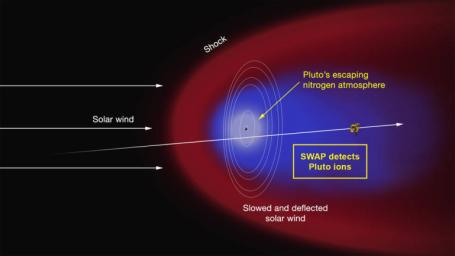
|
Artist’s Concept of the Interaction of the Solar Wind
- Click the image above for a larger view
- Full-Res JPEG (985 x 554) (35.6 kB)
- Full-Res TIFF (985 x 554) (1.6 MB)
Caption:
Artist's concept of the interaction of the solar wind (the supersonic outflow of electrically charged particles from the Sun) with Pluto's predominantly nitrogen atmosphere. Some of the molecules that form the atmosphere have enough energy to overcome Pluto's weak gravity and escape into space, where they are ionized by solar ultraviolet radiation. As the solar wind encounters the obstacle formed by the ions, it is slowed and diverted (depicted in the red region), possibly forming a shock wave upstream of Pluto. The ions are "picked up" by the solar wind and carried in its flow past the dwarf planet to form an ion or plasma tail (blue region). The Solar Wind around Pluto (SWAP) instrument on the New Horizons spacecraft made the first measurements of this region of low-energy atmospheric ions shortly after closest approach on July 14. Such measurements will enable the SWAP team to determine the rate at which Pluto loses its atmosphere and, in turn, will yield insight into the evolution of the Pluto's atmosphere and surface. Also illustrated are the orbits of Pluto's five moons and the trajectory of the spacecraft.
Background Info:
The Johns Hopkins University Applied Physics Laboratory in Laurel, Maryland, designed, built, and operates the New Horizons spacecraft, and manages the mission for NASA's Science Mission Directorate. The Southwest Research Institute, based in San Antonio, leads the science team, payload operations and encounter science planning. New Horizons is part of the New Frontiers Program managed by NASA's Marshall Space Flight Center in Huntsville, Alabama.
Cataloging Keywords:
| Name | Value | Additional Values |
|---|---|---|
| Target | Pluto | |
| System | Pluto | Kuiper Belt |
| Target Type | Dwarf Planet | KBO |
| Mission | New Horizons | |
| Instrument Host | New Horizons | |
| Host Type | Flyby Spacecraft | |
| Instrument | ||
| Detector | ||
| Extra Keywords | Artwork, Atmosphere, Color, Ultraviolet | |
| Acquisition Date | ||
| Release Date | 2015-07-17 | |
| Date in Caption | ||
| Image Credit | NASA/Johns Hopkins University Applied Physics Laboratory/Southwest Research Institute | |
| Source | photojournal.jpl.nasa.gov/catalog/PIA19719 | |
| Identifier | PIA19719 | |
